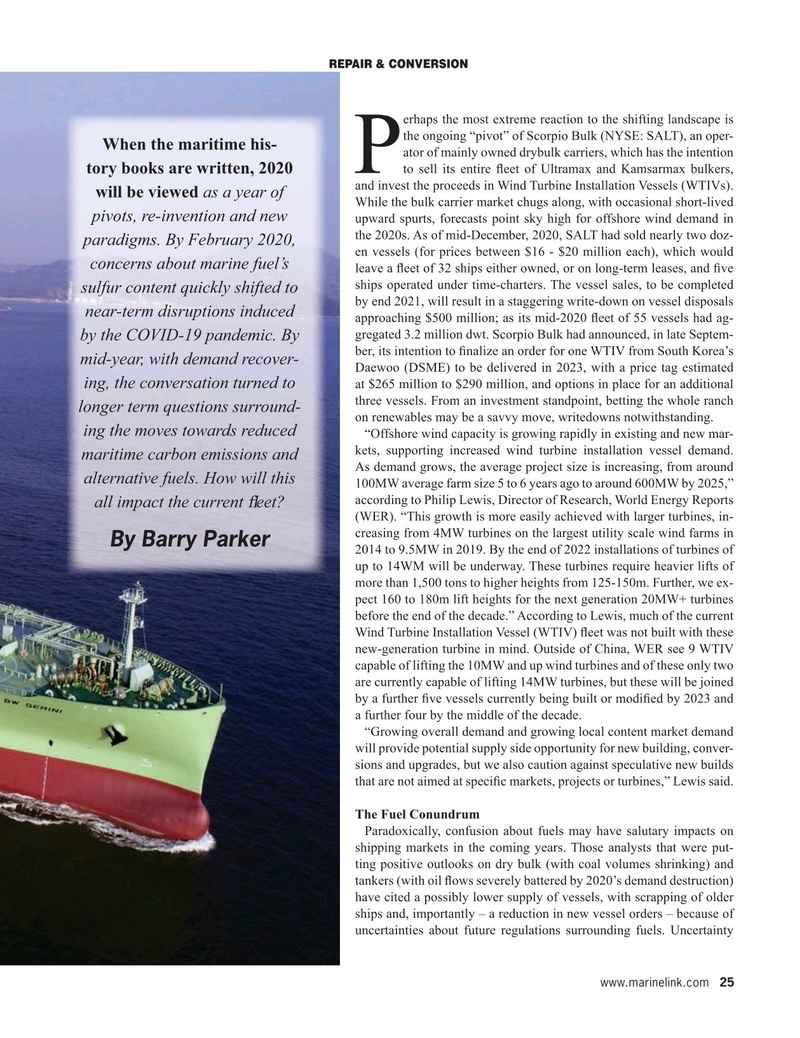
Page 25: of Maritime Reporter Magazine (January 2021)
The Ship Repair & Conversion Edition
Read this page in Pdf, Flash or Html5 edition of January 2021 Maritime Reporter Magazine
REPAIR & CONVERSION erhaps the most extreme reaction to the shifting landscape is the ongoing “pivot” of Scorpio Bulk (NYSE: SALT), an oper-
When the maritime his- ator of mainly owned drybulk carriers, which has the intention
P to sell its entire ? eet of Ultramax and Kamsarmax bulkers, tory books are written, 2020 and invest the proceeds in Wind Turbine Installation Vessels (WTIVs). will be viewed as a year of
While the bulk carrier market chugs along, with occasional short-lived pivots, re-invention and new upward spurts, forecasts point sky high for offshore wind demand in the 2020s. As of mid-December, 2020, SALT had sold nearly two doz- paradigms. By February 2020, en vessels (for prices between $16 - $20 million each), which would concerns about marine fuel’s leave a ? eet of 32 ships either owned, or on long-term leases, and ? ve ships operated under time-charters. The vessel sales, to be completed sulfur content quickly shifted to by end 2021, will result in a staggering write-down on vessel disposals near-term disruptions induced approaching $500 million; as its mid-2020 ? eet of 55 vessels had ag- gregated 3.2 million dwt. Scorpio Bulk had announced, in late Septem- by the COVID-19 pandemic. By ber, its intention to ? nalize an order for one WTIV from South Korea’s mid-year, with demand recover-
Daewoo (DSME) to be delivered in 2023, with a price tag estimated ing, the conversation turned to at $265 million to $290 million, and options in place for an additional three vessels. From an investment standpoint, betting the whole ranch longer term questions surround- on renewables may be a savvy move, writedowns notwithstanding. ing the moves towards reduced “Offshore wind capacity is growing rapidly in existing and new mar- kets, supporting increased wind turbine installation vessel demand. maritime carbon emissions and
As demand grows, the average project size is increasing, from around alternative fuels. How will this 100MW average farm size 5 to 6 years ago to around 600MW by 2025,” according to Philip Lewis, Director of Research, World Energy Reports all impact the current ? eet? (WER). “This growth is more easily achieved with larger turbines, in- creasing from 4MW turbines on the largest utility scale wind farms in
By Barry Parker 2014 to 9.5MW in 2019. By the end of 2022 installations of turbines of up to 14WM will be underway. These turbines require heavier lifts of more than 1,500 tons to higher heights from 125-150m. Further, we ex- pect 160 to 180m lift heights for the next generation 20MW+ turbines before the end of the decade.” According to Lewis, much of the current
Wind Turbine Installation Vessel (WTIV) ? eet was not built with these new-generation turbine in mind. Outside of China, WER see 9 WTIV capable of lifting the 10MW and up wind turbines and of these only two are currently capable of lifting 14MW turbines, but these will be joined by a further ? ve vessels currently being built or modi? ed by 2023 and a further four by the middle of the decade. “Growing overall demand and growing local content market demand will provide potential supply side opportunity for new building, conver- sions and upgrades, but we also caution against speculative new builds that are not aimed at speci? c markets, projects or turbines,” Lewis said.
The Fuel Conundrum
Paradoxically, confusion about fuels may have salutary impacts on shipping markets in the coming years. Those analysts that were put- ting positive outlooks on dry bulk (with coal volumes shrinking) and tankers (with oil ? ows severely battered by 2020’s demand destruction) have cited a possibly lower supply of vessels, with scrapping of older ships and, importantly – a reduction in new vessel orders – because of uncertainties about future regulations surrounding fuels. Uncertainty www.marinelink.com 25
MR #1 (18-33).indd 25 1/7/2021 4:41:57 PM

 24
24

 26
26
